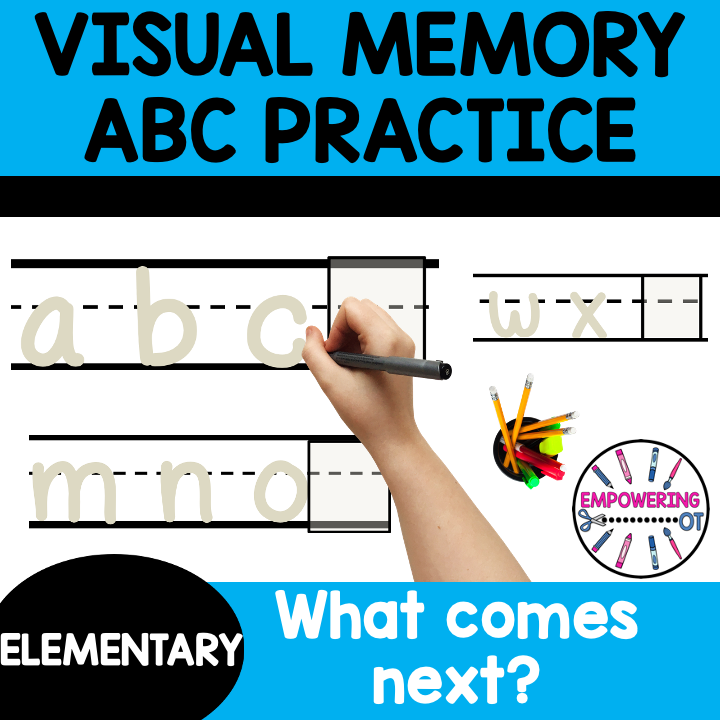Orthographic Memory Integration (visual memory- see information below) may be the missing link in your handwriting program! Students must add the next letter in the sequence. The harder pages include listening to the teacher say sequences that the students must write and add the next letter.
This packet focuses on students remembering how to form letters and remembering the sequences of alphabet. You will be surprised when you do this with students, as many students have difficulty with this visual memory for handwriting.
This is perfect for RTI / MTSS as an intervention for hand strength and pre-handwriting skills.This is great for visual scanning, visual perceptual skills, coordination, visual motor integration and fine motor. This is also a perfect activity for occupational therapists OT, teachers, speech pathologists SLP, special education SPED teachers and other school professionals while working on skills!
I am a school occupational therapist who has a doctorate in occupational therapy. I work closely with special education and general education staff adapting material. This is where I get my inspiration for this material. I have used my materials with a variety of children with different disabilities including learning disabilities, dyslexia, autism, sensory processing disorder, ADD, ADHD, visual impairments, deaf/hard of hearing, cerebral palsy, down syndrome and more.
DISCLAIMER: By using this, you agree that this activity is not intended to replace the advice of a physician or occupational therapist. Information provided should not be used for diagnostic or training purposes. Please speak with your physician or OT if you have questions. Stop any activity if you are unsure about a child’s reaction or ability
Orthographic Motor Integration (Visual memory)
•Orthographic motor integration is the ability to store and retrieve from memory how letters look and also how to form letters.
•This requires students to retrieve letter sequences (ie: the alphabet) and then also form the letters from motor patterns.
•OMI can be a very important factor of students with poor handwriting (Volman et al., 2006; Horne, Ferrier, Singleton & Read, 2011).
•Automatic letter writing (ie: writing a letter without looking at a model) may be a significant impact on both length and quality of written work for both primary (
•Berninger and Graham’s (1998) and upper grades (Medwell et al. (2009)
•My products address specifically OMI.
–Differentiated Practice for Visual Memory (This packet)
–B, d reversal superpack, that includes students having to write from memory: https://www.teacherspayteachers.com/Product/b-d-reversals-SUPER-PACK-games-research-based-practice-visuals-for-desk-3465479
–Follow me for notofication when I post more: https://www.teacherspayteachers.com/Store/Empowering-Ot-By-Dr-R
References:
Berninger, V. W., & Graham, S. (1998). Language by hand: A synthesis of a decade of research on handwriting. Handwriting Review, 12, 11-25.
Berninger, V. W., Vaughan, K. B., Abbott, R. D., Abbott, S., Brooks, A., Rogan, L. Reed, E. & Graham, S. (1997). Treatment of handwriting fluency problems in beginning writers: Transfer from handwriting to composition. Journal of Educational Psychology, 89(4), 652-666.
DeCoste, D. (2014). The DeCoste Writing Protocol:Evidence-Based Research to Make Instructional And Accommodation Decisions. Volo, IL: Don Johnston, Inc.
Horne, J., Ferrier, J., Singleton, C., & Read, C (2011). Computerized asssessment of handwriting and typing speed. Educational and Child Psychology, 28(2), 52-66.
Medwell, J. Strand, S. & Wray, D. (2009). The links between handwriting and composing for Y6 children. Cambridge
Journal of Education, 39(3), 329-344.
Volman, M. J., van Schendel, B. M., & Jongmans, M. J. (2006). Handwriting difficulties in primary school children: a searc h for underlying mechanisms. American Journal of Occupational Therapy, 60, 451-460.
$3.50
Quick Links
Copyright © 2020 Empowering OT | All Rights Reserved

